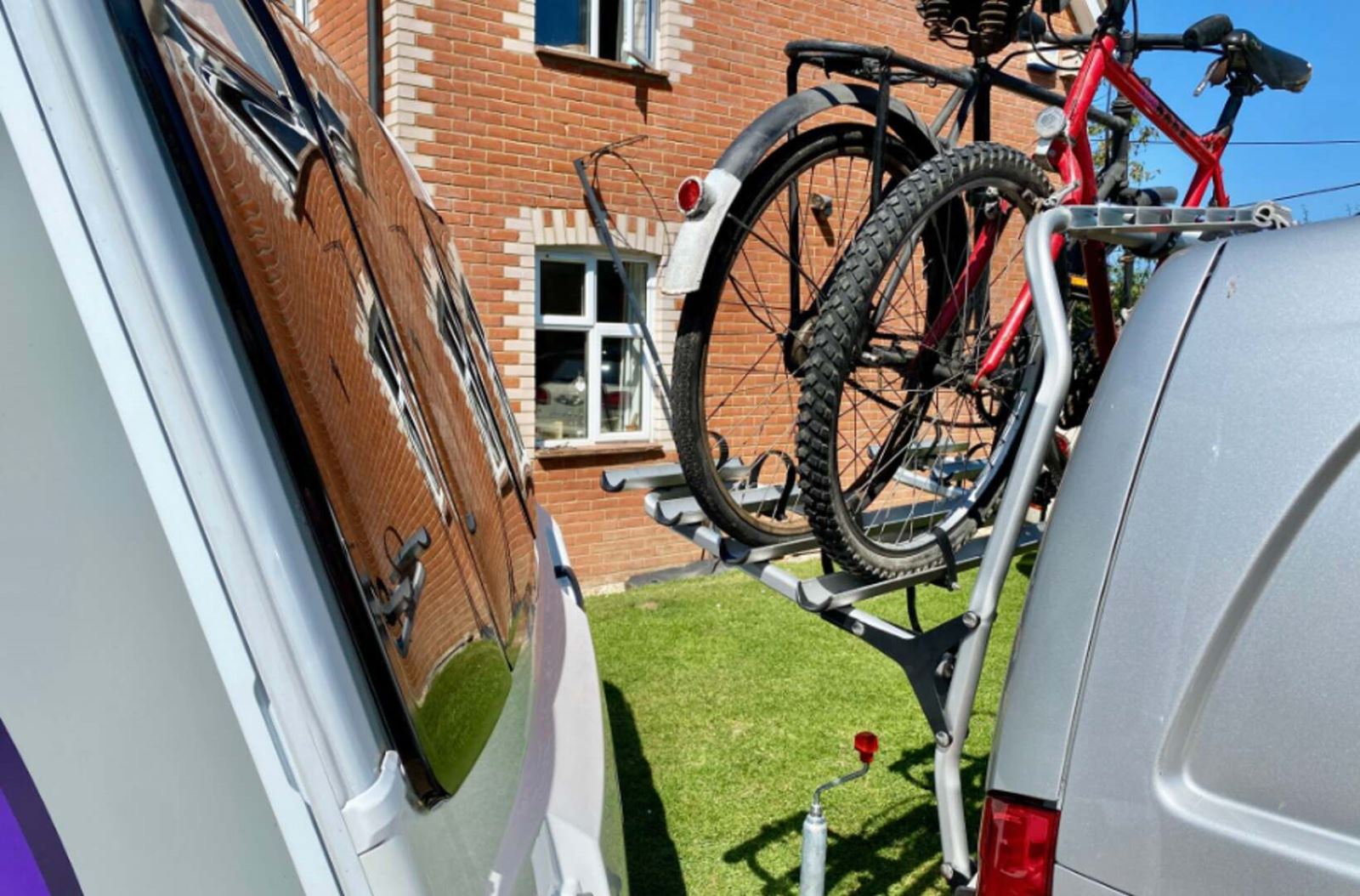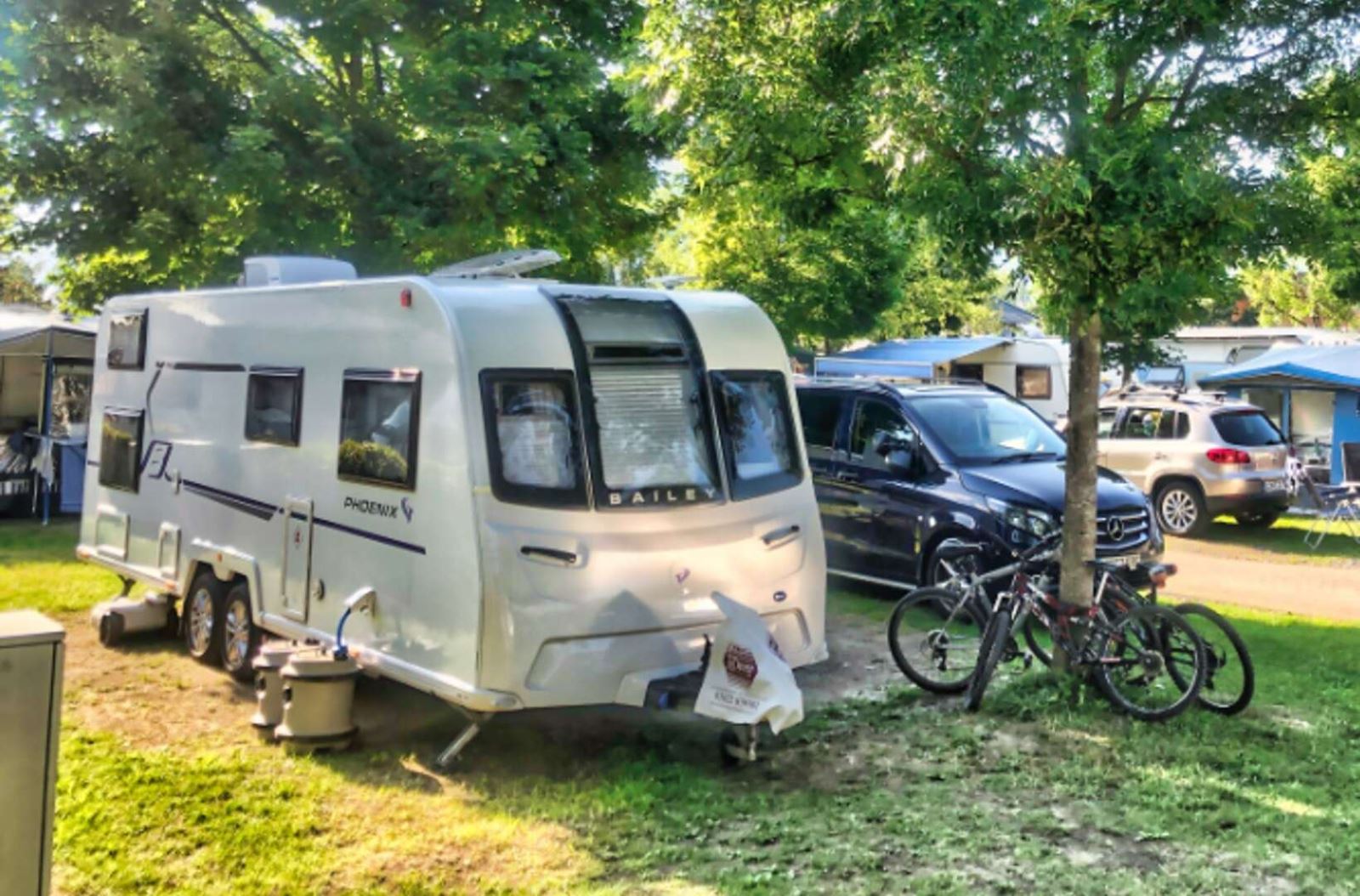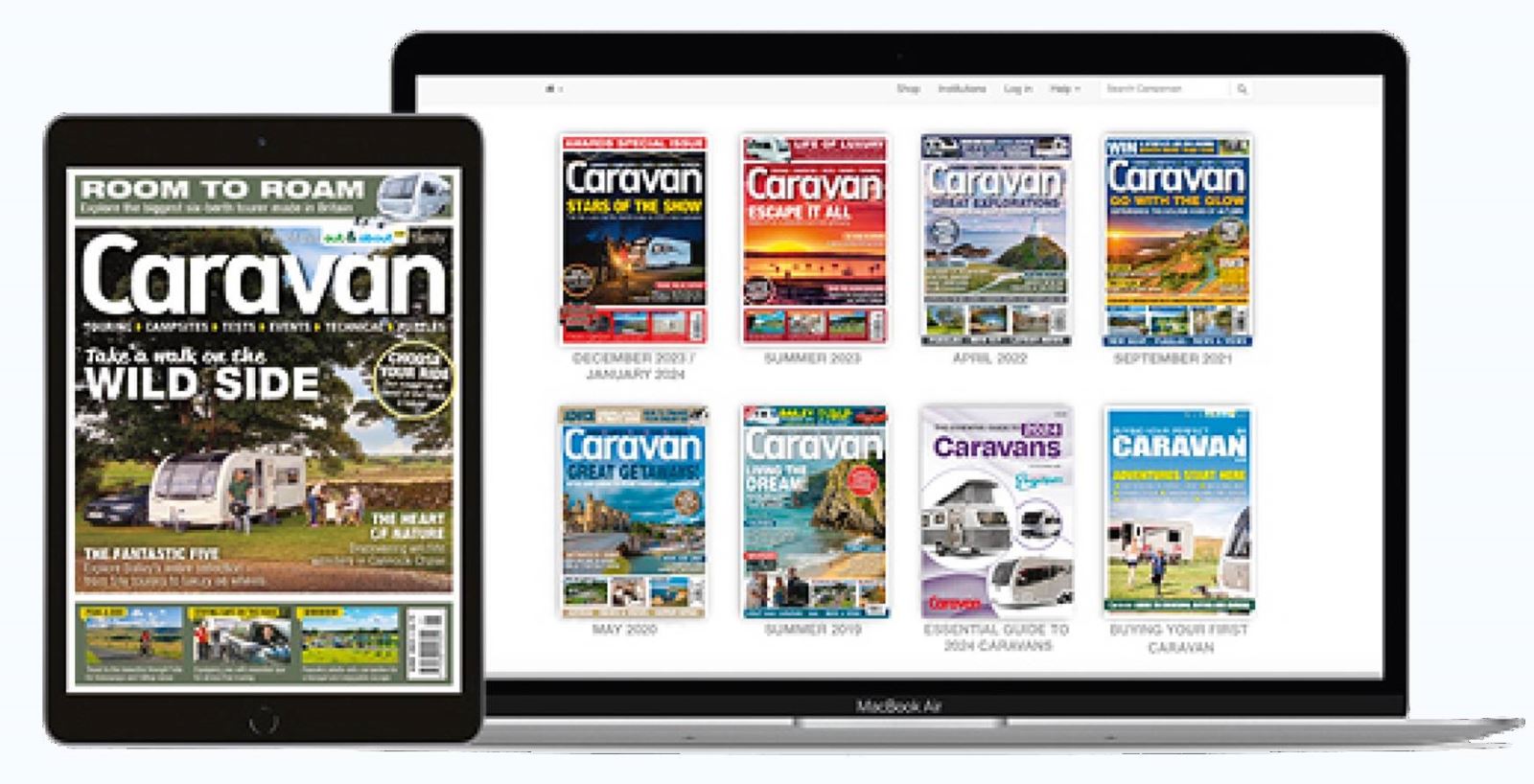Caravan bike racks: a complete guide
A caravan bike rack allows you to transport bicycles easily, making two-wheeled exploration from the campsite an easy and enjoyable pastime.
Many types of cycle carriers exist, although not all are suitable for certain types of cars, caravans, or the bicycles we wish to carry.
We'll discuss which types of bike racks are popular with caravanners and any pros, cons, or weight restrictions these racks and their cargo may have.
Page contents
- Types of bike racks
- Carrying E-bikes
- Transporting bikes inside the caravan
- FAQs
- Final thoughts
- About our magazines
Words by Lee Davey
Types of bike racks
We'll be looking at the following types of bike racks:
- A-frame bike rack
- Towball-mounted bike rack
- Rear-mounted bike rack
- Roof-mounted bike racks
- Tailgate cycle carrier
A frame rack

(Photo courtesy of Jim Blackstock)
A caravan A-frame bike rack is a clever solution, although the caravan does need a relatively long A-frame to accommodate bikes and a dedicated carrier. Longer A-frames are more prevalent on continental caravans than UK models, although Bailey adopted this principle on their Discovery range.
The make and model of your caravan will allow you to use this type of cycle carrier, or it will exclude it. The manufacturer of your caravan or a member of the dealer network will be able to provide further information.
Tow ball mounted rack
One type of tow ball-mounted bike rack clamps between the tow ball and tow bar, while the other fixes to the bottom of a swan neck tow ball. It mustn't be confused with a bike rack that clamps to the tow ball itself, as this wouldn't allow the caravan to be towed while using the bike rack.
Clearance must be checked between the bicycle(s) and caravan when turning or manoeuvring. If using this type of bike rack when not towing a caravan, a lightboard may be required if the rack or bicycle obscures the car's number plate or lights.
Rear-mounted bike rack

(Photo courtesy of Lee Davey)
This type of bike rack attaches to the rear of a caravan but must only be used on caravans specifically designed for such a carrier, as it can only be fitted to caravans with dedicated mounting points. It is similar in appearance to a motorhome bike rack.
Being located at the rear of the caravan, weight must be considered, and the maximum limit specified by the caravan manufacturer must not be exceeded. The caravan's nose weight will also need checking.
If you choose a rear-mounted caravan bike rack, bear in mind there will be extra weight at the rear from the caravan bike carrier and bicycles, which may cause instability.
Roof-mounted bike racks
I used this cycle carrier type for many years on a Volvo estate. Fixing to the car's roof bars or roof rack, a roof-mounted rack allowed us to carry bicycles without affecting the caravan's weight limit. Height-wise, the bikes were no taller than the caravan, so we didn't have to consider additional height restrictions, and the caravan step was handy for loading and unloading.
Your car will have an overall weight restriction and a limit for any roof-mounted loads, so it's worth checking these before purchasing a roof-mounted bike rack.
Tailgate cycle carriers
I currently tow with a Vito and I find the tailgate-mounted carrier is a great bike rack for caravan use. I've used the same type on a VW Transporter. This type of bike rack fits on the tailgate, and as with a roof-mounted carrier, it removes any caravan-related weight considerations. However, opening the tailgate with a bike attached can be problematic.
When using the carrier for the first time, it's worth checking clearances between the carrier and the caravan, as the ends of the rack can appear uncomfortably close to the caravan's front windows when reversing onto a pitch. I tend to mount the carrier, load the bicycles, and test by turning as far as I can while a helper keeps a watchful eye.
Carrying E-bikes
There is a growing trend for e-bikes, and when it comes to transporting them, the downside is an overall weight that may be 50% heavier than a standard bike. The bike rack needs to be able to support this extra weight.
Many caravanners remove the battery (where possible) and store it separately to reduce weight, but any additional weight that an e-bike may have must be considered.
Transporting bikes inside the caravan
I have occasionally carried bicycles inside the caravan, but there are specific considerations when doing so. Weight is an obvious consideration, as not only will the bicycle(s) eat into your payload, but your nose weight will likely be affected.
The bikes need to be secured so they don't damage internal fixtures and fittings. Any movement when travelling, such as the bikes moving forward or backwards, could alter your nose weight mid-journey. When I carried bikes inside the caravan, they were small and light.
FAQ

(Photo courtesy of Lee Davey)
Can you put a bike rack on the back of a caravan?
Yes, although the caravan must be designed to accommodate this type of bike rack. As this extra load will be at the caravan's rear, weights must be checked carefully.
Can you tow a caravan with a bike rack fitted?
Yes. Bike racks fitted to A-frames, car roof bars, tailgates, the rear of caravans, and certain tow ball-mounted carriers can be used when towing a caravan.
How to fit a bike rack to a caravan
Fitment depends on the type of bike rack used, but they are generally clamped or bolted into position.
Can you put a bike rack on a caravan?
Yes. The two most common types of bike rack that fit to a caravan are A-frame or rear-mounted units.
What is the best way to carry a bike on a caravan?
It varies depending on your caravan, available payload, nose weight, and personal preferences.
Can I put the bikes inside the caravan when towing?
You can, although it will inevitably affect the caravan's nose weight and eat into any available payload. If the bikes are light, well secured, and you have spare payload, check the nose weight before setting off.
Are there any special rules when travelling abroad?
Certain countries have restrictions. Those planning to drive through Spain, Portugal, or Italy must display a marker board when carrying an overhanging load, such as a cycle carrier. Check before travelling as regulations often vary between countries.
Which brand of bike carrier is suitable for a caravan?
The Fiamma Carry range and Thule bike racks are popular with caravanners. However, each brand or type of cycle carrier must be reviewed to ensure that it suits your needs and the weight-carrying capacity of your car or caravan.
Final thoughts
Taking bikes with you is part of the adventure, but, in short, towing is primarily about weight and stability. Nose weight, payload, and balance are important factors for safe towing.
A bit of homework is needed to determine the carrying capacity of your car and caravan to see what additional weight can be safely accommodated. A bike rack can then be chosen based on personal preferences.
Stay safe, enjoy exploring your surroundings by pedal power, and ensure that any bicycles are also secured against potential theft.
Watch our latest video
Join the CaravanTV family
Caravan TV is your first port of call for all you need to know about caravanning - from caravan reviews to demonstrations and instructional videos, Caravan has over 90 years of expertise.
We bring you the very latest in caravan news as well as new tech and reviews.
Get Caravan magazine from just £19.99

Caravan magazine has been inspiring caravanners for more than 80 years! Every monthly issue is packed with caravan travel inspiration, the best sites to stay on, caravan road tests, reviews and buying guides, plus top technical advice.
Caravan’s fully searchable digital library gives you access to the latest issues, plus every edition of Caravan since February 2013.
Expert Caravan advice to your door!

Caravan magazine has been inspiring caravanners for more than 80 years! We have grown to become a leading authority on caravans, the caravan industry, caravan lifestyle, campsites and caravan travel destinations. We know what our readers want – and that's to make the most of their caravans and their holidays!
Want to know more about Caravan magazine?
About Caravan magazine








Recent Updates
Caravan chassis: all you need to know
A caravan chassis is a skeletal frame that runs from front to back, supporting the body and linking the entire structure to the axle or axles ...
Caravan cooking recipes
Caravan cookery inspirational ideas. No need to stress out in the kitchen with these quick and easy ...
Caravan satellite dish guide: everything you need to know
Few holiday types can rival the escapism of the humble caravan, but we all love to sit back and relax in ...
Caravan insurance: all you need to know
Navigating the world of caravan insurance can feel like a daunting task. Fear not, as this comprehensive ...
Caravan tyres: everything you need to know
In this tyre guide, we'll explain everything you need to know about looking after your caravan tyres and ...
Caravan solar panels: all you need to know
Whether you dream of roaming off-grid or just fancy reducing your carbon footprint, fitting solar panels to ...
Caravanning with dogs: all you need to know
Caravan holidays with dogs are a joy for lots of reasons. Firstly, many people choose to buy a caravan ...
How to set up a caravan: all you need to know
Setting up your caravan on a campsite pitch is just a sequence of actions. They’re second nature to ...
Caravan showers: all you need to know
In this guide, we’ll discuss the different types of showers, how they work, and how to fit an external shower ...
Towing a caravan: all you need to know
Towing a caravan may seem daunting initially, but a few simple tips can make the journey enjoyable and ...
Other Articles
Towbars & towballs: all you need to know
Flange, detachable, swan neck, retractable – towbar technology choice is bewildering. Don’t worry. We’ll explain the options and cut through the ...
Caravan WiFi: everything you need to know
Caravan holidays are the ultimate way of getting away from it all, although we sometimes need a link to the ...
Buying a caravan: what you need to know
Let us guide you through some of the complicated things to think about when first looking at buying a ...
Caravan awnings: a buyers' guide
Caravan awnings are a fantastic addition to any caravan as they are one of the simplest, quickest and most ...
Caravan electrics: avoid tripping out
All caravan owners have overloaded their mains supply at some time. Here’s how to master caravan electrics ...
Caravan heating systems: a quick guide to caravanning warmth
When winter is here, you’ll be glad of a decent caravan heating system if you’re out touring. Here’s how the ...
Caravan damp: a complete guide
There's little more guaranteed to strike fear into the heart of a caravan owner than the word 'damp'. But if ...
Caravan jockey wheels: the definitive guide
A well-functioning caravan jockey wheel can make all the difference to manoeuvring away from the towcar, ...
The ultimate guide to caravan layouts
Choosing the right layout or floorplan of your caravan is an all-important part of the buying process – find ...
A guide to seasonal caravan pitches
Our in-depth guide to finding and securing seasonal caravan pitches on your favourite campsite ...